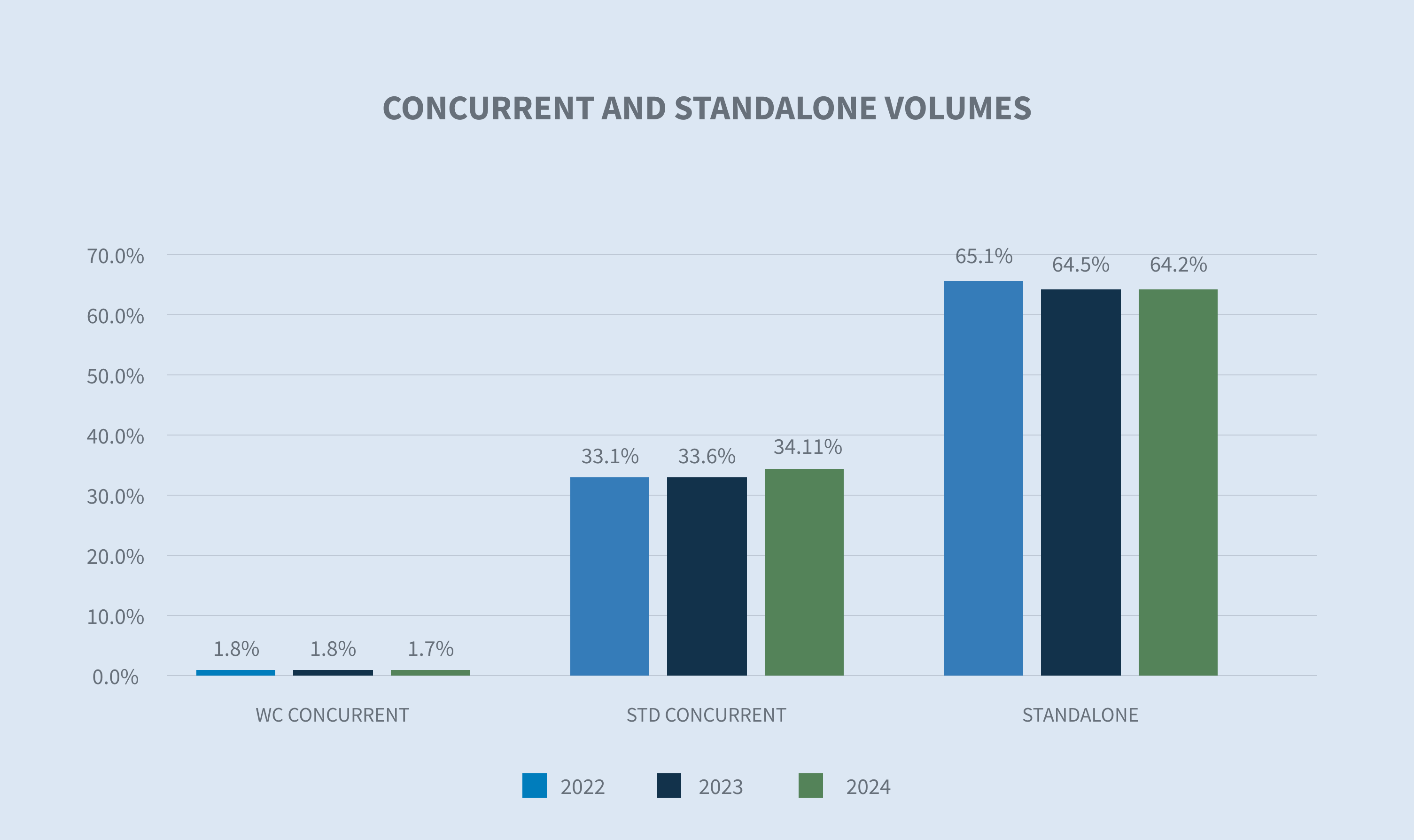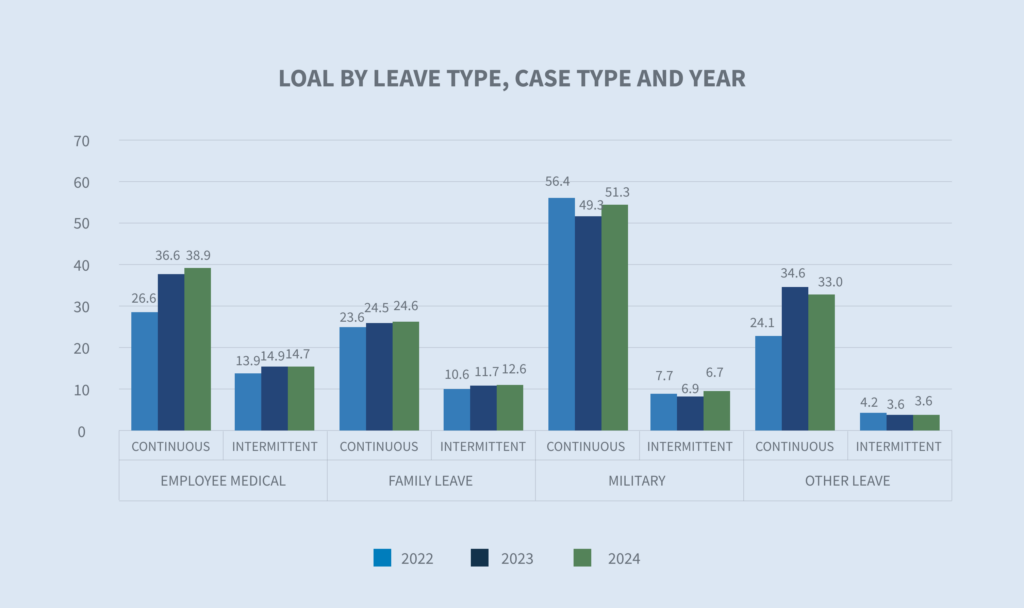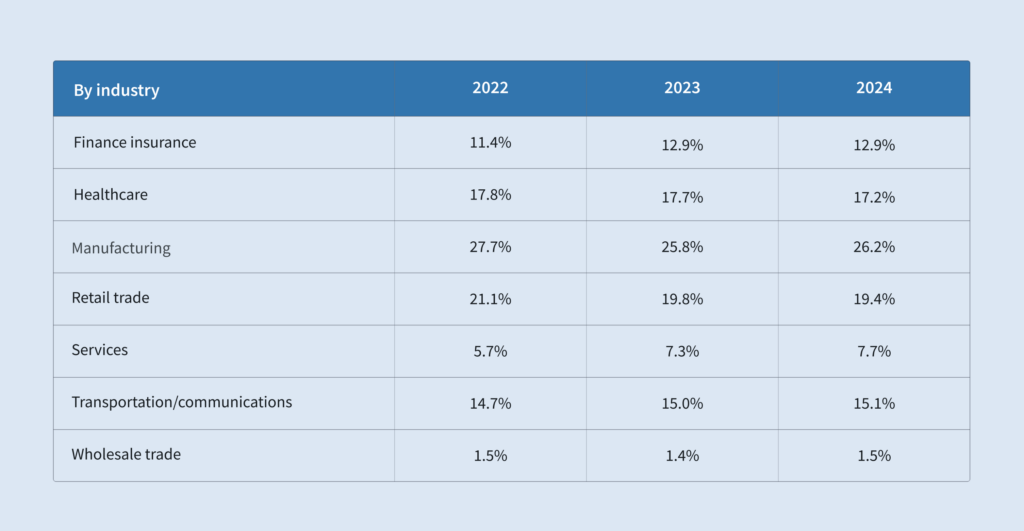
- Summer 2024: BENEFITS
Leave of absence
Report objectives
This report aims to summarize the present metrics for our leave of absence (LOA) programs, assess the landscape of leave case administration and litigation, and benchmark our patterns against comparable industry research.
data parameters
Our practice team uses TAMS claims data to perform comparative analyses informed by their expertise and analytics. The data in this report is based on the first half of each year, January through June, for each reporting year.
Unpaid leave data includes standalone cases only, meaning there is no concurrent disability claim. This is to avoid double-counting cases that are simply running in the background of a disability claim, while disability is the primary claim. Data on unpaid leave running concurrently with disability would mirror the disability report.
Key observations
Unpaid leave volumes have remained stable in 2024, with an increase of only 0.7% compared to 2023. The record high in January 2022, driven by an unprecedented spike in COVID-related leaves, still stands out. However, volumes and incident rates quickly declined in 2022 and stabilized into 2023, resulting in an overall incident rate decrease from 17.1% to 15.3%.
The types of leaves being reported are shifting away from other leave (which includes COVID-19 personal leave policies) and returning to employee medical and family leaves. Bereavement leaves are becoming more prevalent, now accounting for 15.9% of company leaves, up from 13.4% in 2023.
Leave approval rates for FMLA increased 2.3% in 2024. In 2023, approval rates decreased, primarily due to missing or incomplete certifications. These issues continue to be the main reason for initial denials, with such denials increasing by 3.9% in 2024 compared to the previous year.
The length of approved leave (LOAL) for continuous leaves increased 1.3% compared to the prior year and has been trending upward over the past three years. This increase is primarily driven by employee medical leaves, which saw a three-day rise compared to 2023. Military leave also experienced an increase of about two days in 2024 compared to 2023. Additionally, intermittent leave durations increased by 1.1% year-over-year, with higher usage observed in family leave and military leave.
Paid leave volumes continue to rise, with new claim volumes increasing by 7% in 2024 compared to 2023. This growth was primarily driven by statutory leaves.

New York Paid Family Leave (NYPFL) and California Paid Family Leave (CAPFL) continue to constitute the majority of statutory paid leave claims, accounting for 49.7% and 35.1%, respectively. The incident rate for NYPFL increased from 5.9% in 2023 to 6.4% in 2024, while CAPFL’s incident rate rose from 2.2% in 2023 to 2.6% in 2024.
Unpaid leave
New case volumes
It is normal to see an increase of new case volumes in Q1, as plans that run on a calendar year may require a new case to be opened when the year rolls over. While there was a slight increase in January of 2024, the overall volumes stayed consistent, and no significant spikes were observed. Incident rates have continued to drop into 2024, with continuous incident rates at 8.9% and intermittent at 7%.


Unpaid leave incident rates spiked in 2020 at the onset of the pandemic. Over the past three years, we have seen incident rates slowly normalize. Rates in 2024 are more in line with 2019 when the continuous incident rate was 8.2%. Moving forward, COVID-19 claims should no longer impact leave incident rates significantly.

New leaves by leave type
Employee medical leave and family leave cases make up the largest percentages of all new leave cases. Their volumes have remained stable from 2024 compared to 2023. Military leave saw a 0.1% increase in 2024 compared to 2023 and has been trending upward over the past three years.


New leaves by case type
Employee medical leaves have continued to trend upward in 2024, showing an increase of nearly 3% to 59.1% in 2024 compared to 56.7% in 2023. Family leaves have also shown an increase in intermittent leaves, increasing from 36.7% in 2023 to 38.1% in 2024.

Other leaves, which include any company leave other than employee medical, family or military leave, are still dominated by personal leaves. However, over the past three years, requests for personal leaves decreased by 11%, as companies have begun offering increased leave benefits for bereavement or unapproved leave programs.


New leaves by age
The average age of claimants filing standalone leave has remained constant over the past three years. There was an increase in claimants ages 55 and older and in claimants between 35 to 45 in 2024, both shifts of less than 1%. We saw increased short-term disability (STD) claim volumes for the 35 to 45 and 45 to 55 age groups, which correlates with this data as well.

New leaves by length of service (LOS)
Standalone leave requests from the three years or less LOS group have increased slowly over the past few years, and currently, this group makes up 41.48% of new leave cases reported in 2024. Given the market realignment that took place in 2021 and 2022, we expect the three to five length of service group to become the leading driver of claims in the next nine to 18 months.

Leave denial reasons
Approval rates for FMLA have trended upward, which is a change from the previous years when the approval rate was dropping. The approval rate was 66.2% in 2023 and 67.7% in 2024. The increase in approval rates for non-FMLA leaves is similar to the trend seen in the FMLA approval rates, shifting from 74.9% in 2023 to 76.3% in 2024.

The most common reason for an initial leave denial is missing or incomplete certification. This is the same trend seen in disability claims; as claimants struggle with access to care or learning how to use telemedicine, the frequency of claimants providing missing or incomplete certifications has continued to increase.

Digging into eligibility denials further, denials due to hours worked not met have been increasing in the past few years, shifting from 41.7% in 2023 to 44.3% in 2024. This difference was offset by increasing denials due to employment length and policy.


Length of approved leave
Overall length of approved leave (LOAL) on continuous leaves shows an increase under employee medical leave type and family leave type and military from 2023 to 2024. Intermittent leaves also show an increase in military leave type and family leave type.
The LOAL on continuous leave varies by leave type. Employee medical LOAL increased by 5.7%, family medical increased by 1.2% and military increased by 4.1%.
On the intermittent side, family leave cases increased by one day, and nearly two days for military leave cases.

Industry trends
Standalone leave volumes decreased, stabilizing across every industry.

Leave incident rates are down in every industry except wholesale trade, an industry that typically has lower incident rates.

Paid leave
New claim volumes
New paid leave claim volumes increased 19% from 2021 to 2022 and are continuing to increase as more states implement paid state leave policies. In 2024, new claim volumes increased 7% compared to 2023; both company paid leave and state paid leave claim volumes increased in 2024. Company paid leaves increased by 5.4% compared to 2023, and state leaves increased 14.2% in 2024 compared to 2023. An additional rise in statutory paid leaves can be expected as multiple new states mandate paid leave over the next few years.

Company paid leaves
Company paid leave durations have remained consistent over the past few years, with a slight increase of 0.2% for 2024 at 46.4 average days compared to 46.3 average days used in 2023.

Statutory paid leaves
Oregon Paid Family Leave (ORPFL) and Colorado Paid Family Leave (COPFL) were both recently added in the last year. Since both states are relatively new in terms of reporting data, there is no year-over-year or trending data. A better understanding of claim volumes should be available by the end of 2024. California and New York account for most of the state reporting and claims filed, similar to what we saw in 2023.

California durations decreased 1% and average costs increased 2.7% as of mid-year 2024. New York durations increased 1.9% and average costs increased 9.8% as of mid-year 2024. As wages increased in 2023, it is not surprising to see the high cost per claim in these two states, where wages are significantly higher than the U.S. average.

Future considerations
Loper Bright Enterprises v. Raimondo
This recent U.S. Supreme Court case overturned a 40-year precedent set in Chevron v. Natural Defense Resource Council. The initial decision in Chevron held that the courts should defer to the appropriate regulatory agencies when the federal legislation is ambiguous or has a gap. Considering Loper, this means that courts no longer must defer to agency interpretation of grey areas. The greatest impact could be felt by agency rulings from the U.S. Department of Labor (DOL) and the Equal Employment Opportunity Commission (EEOC) as it relates to FMLA and Americans with Disabilities Act (ADA) and most recently the Pregnant Workers Fairness Act (PWFA). Further impacts could be felt at the state level if challenges are made to regulatory interpretation to statutory Paid Family and Medical Leave (PFML) benefit programs at the state level.

Expansion of paid leave policies
Paid leave provides financial support (and sometimes job protection) when a new child or a personal or family care need requires an employee to take time away from work. Partially due to the after-effects of COVID-19, employers and politicians better understand how necessary it is to provide paid leave to workers in support of them and their families. Although there is currently a task force in Congress working on a bipartisan federal solution, it is not likely that a federal paid leave option will be passed based on Congress’ current makeup. Therefore, states continue to establish and expand paid leave programs.
Here is a list of recent implementations and expansions:
Washington Paid Family and Medical Leave (WA PFML): Effective Jan. 1, 2025, any interested party will have access to certain records and information related to an employee’s paid family or medical leave claim, including the type of leave being taken, the duration of the leave, and whether the employee was approved for and paid benefits. This Washington amendment defines “interested party” as a current employer, a current employer’s third-party administrator or an employee.
California Paid Family Leave (PFL) and California State Disability Insurance (SDI): For PFL and SDI claims beginning on or after Jan. 1, 2025, individuals who earn 70% or less of the state average quarterly wage (SAWW) will receive a benefit of up to 90% of the average weekly wage (AWW). Individuals who earn more than 70% of the state average quarterly wage will receive a benefit of up to 63% of AWW.
Maryland enacted a Family and Medical Leave Insurance programme (FAMLI) on April 9, 2022, effective July 1, 2026.
Delaware enacted the Healthy Delaware Families Act on May 10, 2022, effective Jan. 1, 2026.
Minnesota enacted a Paid Family and Medical Leave Act on May 25, 2023, effective Jan. 1, 2026.
Maine enacted a Paid Family and Medical Leave Act on July 11, 2023, effective May 1, 2026.
Recent state programs have implemented a two-part (and sometimes three-part) formula, providing a higher percentage of wage replacement to lower-wage workers. This was done in hopes of supporting people who are more financially insecure. This trend started with Washington providing low-wage earners 90% of their earnings. Minnesota and Maryland will do the same when their benefits take effect in 2026.
States with multi-part formula and the percentage of wage replacement that they offer lower-wage earners:

Generally, the definition of family member has trended to be more inclusive. Recently enacted laws extend the definition of family member beyond parents, spouses and children to include grandparents, grandchildren, siblings, parents-in-law and domestic partners. More importantly and more generously, in six states, family also includes a person “to whom the worker is related to by blood or affinity.” The “blood or affinity” family member definitions are applicable in Washington PFML, New Jersey FLI, Connecticut FMLA and Paid Leave, California Family Rights Act (CFRA), Paid Leave Oregon and Colorado FAMLI. Interestingly, both Maryland and Delaware have both chosen not to follow the trend of implementing this expanded family member definition. Minnesota and Maine continue with the “blood or affinity” relationship as part of their PFML programs.
Upcoming implementations and likely new states
Multiple state-paid leave programs rolled out in 2023 and 2024. Oregon Paid Leave benefits began Sept. 3, 2023, and Colorado FAMLI benefits began Jan. 1, 2024. After that, we have our first 2026 implementations: Delaware and Minnesota will both roll out on Jan. 1, 2026. Maine is slightly behind this first grouping, implementing on May 1, 2026, and Maryland will go live July 1, 2026. That means there will be four new paid family and medical leave programs going live in 2026.
We are also tracking states that are passing group insurance paid family leave programs, which allows individual carriers to offer group insured benefits attached to group disability products. So far six states — Tennessee, Virginia, Florida, Texas, Alabama and Arkansas — have passed this model. It is expected that Kentucky, North Carolina and Pennsylvania may add to this total. This will be a challenge for employers since unlike traditional PFML states which have standardized offerings, carriers may have significantly different product offerings.
Bereavement
New bereavement leaves continue to be added by the states. Effective Jan. 1, 2024, Illinois added two new bereavement leaves to their existing leave programs. Employees may now be eligible to take up to two weeks (10 workdays) of unpaid leave under the existing Victims’ Economic Security and Safety Act (VESSA) related to the death of a family member or household member who is killed in a crime of violence to (1) attend the funeral, funeral alternative, or wake, (2) make arrangements necessitated by the death, and (3) grieve the death of the lost family member or household member. Additionally, under the existing Illinois Family Bereavement Leave Act (FBLA), employees who experience the loss of their child by suicide or homicide are now entitled to take up to 12 weeks (under large employers) or six weeks (under small employers) of unpaid leave from work to grieve the loss of that child.
Our non-FMLA or military leave bucket included only 2.4% bereavement leaves in 2020; that number increased to 11.5% in 2023.
Caregiver leave
Studies show that one-third of the workforce is a caregiver. Consider the “sandwich generation” concept, which is defined as adults who are caring for their children and aging parents simultaneously. As generations and the demographics of the U.S. workforce continue to change, so do employees’ expectations of their employers’ roles in providing leave and support.

Sabbatical leave
Once thought to be the province solely of educational institutions, sabbatical leave is becoming more common, especially as organisations deal with the Great Resignation following the pandemic. A sabbatical is an extended break from work that may be paid or unpaid, and typically lasts anywhere from one month to one year. It provides time to rest, travel and learn new things. We anticipate that more clients may add this benefit.
